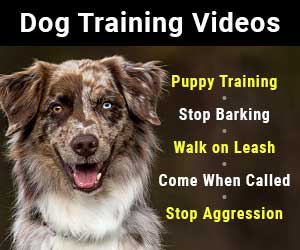
Essentials Of Dog Leash Training
Dog leash training begins with appropriate selection of leashes and collars. There are many materials and designs to choose from. Some are more decorative than functional. Here you will learn all about leash training a dog, beginning with how to choose the right lead and collar.
Most leashes are composed of sturdy nylon. Leather and chain link are available, but they are more expensive and serve only to make the lead look nicer.
For very large dogs, leashes composed of the strongest material like mountain climbing ropes are a good choice. When your dog is properly trained, it might not be essential to have the sturdier lead. But any dog can become excited when he sees a squirrel. Having the extra control provided by a strong lead is a nice option.
Extending leashes seem to be popular among pet owners but... professional trainers recommend against them for several reasons. One is lack of safety.

Pam Martin
Proper dog leash training is essential for all dogs and the sooner you start the better. Above: This is Baylee looking adorable at 12 weeks. Thanks to Pam Martin from Bellevue Michigan for sharing this photo.
Short leashes are preferable for teaching dogs to heel. Those are the types that you see on dog shows. A one to two foot length is sufficient for a medium to large breed. A full grown Australian Shepherd, for example, could be controlled and trained to heel with that length.
Smaller breeds may require three feet or more. You should be able to walk erect, hold the rope taut and still allow your pet to be comfortable. Six foot leashes are the appropriate length for regular (non-show) walks.
You should choose a collar based on your dog's current size. Puppies will grow quickly, but for early sessions, the collar should fit properly. You should be able to slip two fingers under the collar. If it is any looser, it can slide over his head.
For large full-grown breeds, you should be able to slip three fingers between the collar and his neck. This is loose enough to prevent choking or chafing, but tight enough to prevent him from slipping out of the collar and running away.
Ideally dog leash training should begin during puppyhood. He should become accustomed to wearing a collar and understand that leashes are nothing to fear.
Try to convey the idea that getting the leashes out means it is time to go outside. If you become frustrated with a walking session, take a break. If you have a small puppy, pick him up and take him home. It doesn't take a long time to train, but you can expect that several sessions will be necessary before he behaves as you think he should.
Dog Leash Training Needs To Be A Positive Experience
People use different methods for leash training a dog. Positive reinforcement is the method that most trainers prefer.
In the beginning, whenever your pet is walking along beside of you without pulling, you should reward him with praise and/or treats. If he wanders away from you or pulls ahead, do not reward the behavior by pulling back. Stop walking. Stop praising. Wait on him to notice that pulling gets him nowhere. Then call him back to your side. When he returns, you can start walking again.
Many owners fail to take the necessary time for leash training a dog. Without even realizing it, they reward pulling by walking faster. Anytime that he pulls, you should stop and wait.
Consistency is important. Everyone that walks him should understand the rules. It is in your and your dog's best interest. Owners are sometimes pulled down. Dogs sometimes pull loose and run out into traffic. This kind of behavior is due to failure to train.
Their natural instinct is to pull. That's why dogs (at least certain breeds) are so good at pulling sleds. You might think of dog leash training as "unlearning" an instinctual behavior. It's not that hard. It just takes practice.
Video: How to Leash Train an Australian Shepherd Puppy
Courtesy Anne Calmes, Gold Ring Australian Shepherds
Check out this introductory leash training video...
Have Dog Training Questions?
Check out these introductory dog training videos...
I want my dog to stop being aggressive.
I want some help training my new puppy.
I want my dog to stop barking at everything.
Get Australian Shepherd Info, Website Updates, Special Offers, and Cartoons...
FREE GIFT
You'll also receive a free copy of the ebook
My Everyday Dog Training Tools
by professional dog trainer Daniel Abdelnoor, "Doggy Dan"











 Loading Image...
Loading Image...